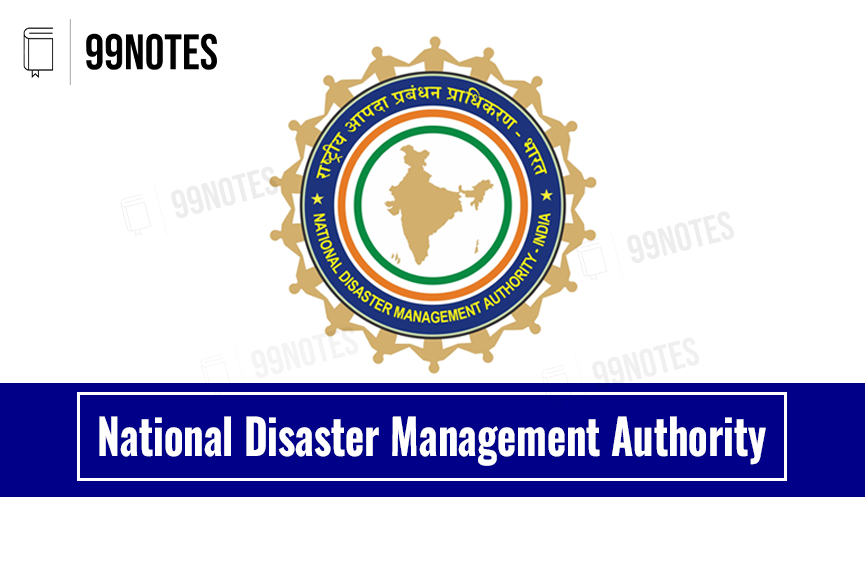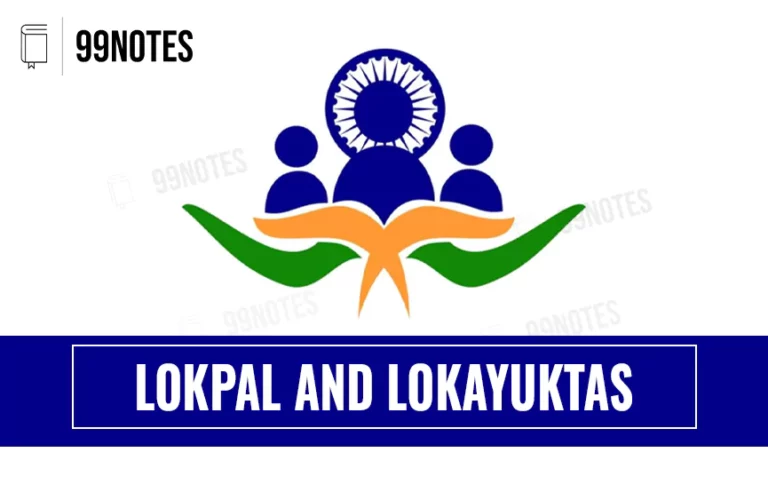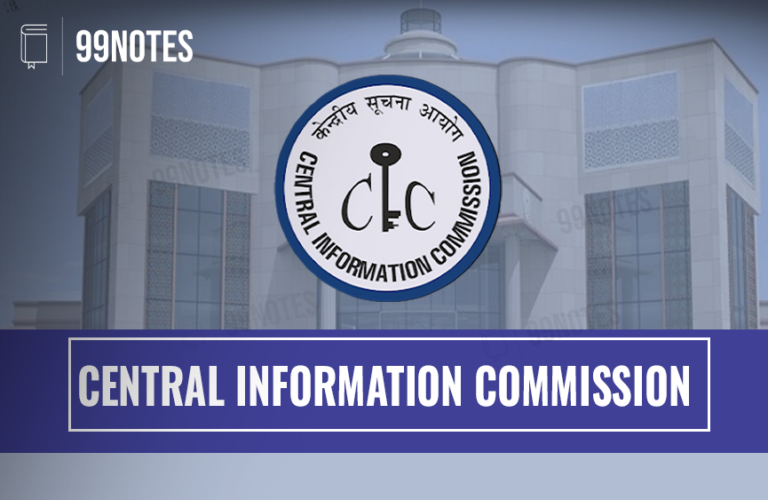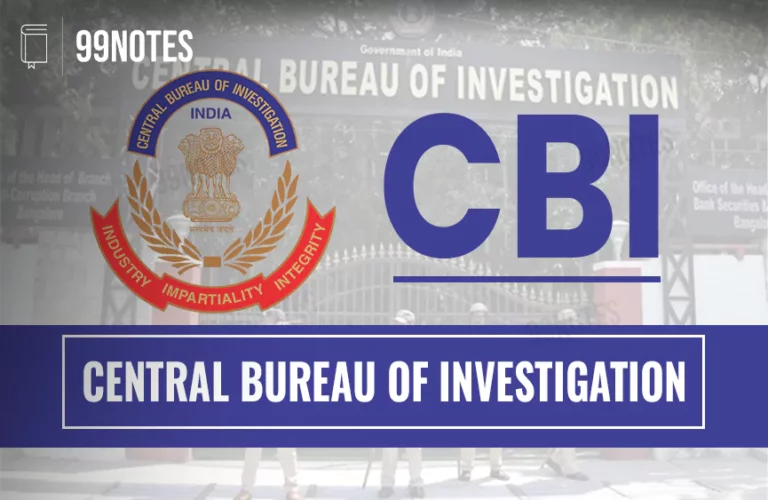National Disaster Management Authority- UPSC Notes
National Disaster Management Authority (NDMA)
National Disaster Management Authority (NDMA) of India is an apex body of the Government of India under the administrative control of the Ministry of Home Affairs (MHA).
The National Disaster Management Authority (NDMA) provides the institutional framework for creating and overseeing disaster management plans. It ensures coordinated efforts across government departments to prevent, mitigate, and respond promptly to disaster situations.
The National Disaster Management Authority Act, 2005 provides for the setting up of the National Disaster Management Authority, headed by the Prime Minister, and State Disaster Management Authorities, chaired by Chief Ministers, and the District Disaster Management Authority. The act creates an enabling environment for institutional mechanisms related to disaster management at the state and District levels.
Evolution of National Disaster Management Authority
As India is a disaster prone country the need arose for an institutional setup to deal with the various disasters like earthquake, Tsunami etc. Successive steps have led to the institutionalisation of the Disaster management framework in India:
- In 1999, the Government of India established a High-Powered Committee to address Disaster Management as a national priority.
- Following the Gujarat earthquake, a National Committee was constituted to make recommendations on the preparation of disaster management plans and suggest effective mitigation strategies.
- The 10th Five-Year Plan (2002-2007) also had a chapter dedicated to disaster management for the first time.
- The 12th Finance Commission was also mandated to review the financial arrangements for Disaster Management.
- Finally, the central government established the NDMA by executive order. Subsequently, the National Disaster Management Act of 2005 was enacted.
Vision of the NDMA
“To build a safer and disaster resilient India by a holistic, pro-active, technology-driven and sustainable development strategy that involves all stakeholders and fosters a culture of prevention, preparedness and mitigation.”
Organizational Structure of the NDMA
- The NDMA consists of a Chairperson and a maximum of nine other members.
- The Prime Minister is the ex-officio chairperson of the authority.
- The chairperson may nominate one member as the Vice-Chairperson of the Authority.
- The Vice-Chairperson has the status of a cabinet minister, while the other members enjoy the status of the Minister of state.
Objectives of the National Disaster Management Authority (NDMA)
The objectives of NDMA are:
- Fostering a culture of prevention, preparedness, and resilience through knowledge, innovation, and education at all levels.
- Advocating mitigation strategies that blend technology, traditional wisdom, and environmental sustainability.
- Integrating disaster management seamlessly into the developmental planning process.
- Establishing institutional and techno-legal frameworks to foster a supportive regulatory environment and compliance system.
- Ensuring an effective mechanism for identifying, assessing, and monitoring disaster risks.
- Developing modern forecasting and early warning systems supported by responsive and secure communication technology.
- Ensuring a caring approach in response and relief efforts, particularly addressing the needs of vulnerable societal segments.
- Approaching reconstruction as an opportunity to construct disaster-resilient structures and habitats for safer living.
- Cultivating a constructive and proactive partnership with the media for effective disaster management.
Functions and Responsibilities of the NDMA
As the premier body for disaster management in India, NDMA is responsible for implementing policies, plans, and guidelines to ensure timely and effective responses to disasters. Its statutory functions include the responsibility to:
- Formulate disaster management policies.
- Sanction the national plan and ensure plans for central government ministries/departments are in line with the national plan.
- Establish guidelines for State authorities in formulating State plans.
- Set guidelines for central government ministries/departments to integrate disaster prevention or mitigation measures into their development plans and projects.
- Coordinate the enforcement and execution of disaster management policies and plans.
- Recommend allocation of funds for mitigation purposes.
- Extend support to other countries affected by significant disasters, as determined by the central government.
- Take necessary measures for disaster prevention, mitigation, preparedness, and capacity building for potential disaster situations.
- Outline general policies and guidelines for the operation of the National Institute of Disaster Management (NIDM).
- Exercise overall supervision, direction, and control of the National Disaster Response Force (NDRF) for specialized response to threatening disasters.
- Authorize relevant departments or authorities to make emergency procurement of provisions or materials for rescue and relief during threatening disasters.
- Propose guidelines for the minimum standards of relief for individuals affected by disasters.
Note: NDMA is mandated to deal with all types of disasters, natural or man-made. However, emergencies involving the direct participation of security forces or intelligence agencies, such as terrorism, counter-insurgency, law and order issues, serial bomb blasts, hijackings, air accidents, Chemical, Biological, Radiological, and Nuclear (CBRN) incidents, mine disasters, ports and harbour emergencies, forest fires, oil field fires, and oil spills, will still be managed by the existing mechanism, i.e. National Crisis Management Committee (NCMC).
State Disaster Management Authority (SDMA)
The NDMA Act of 2005 provides for the establishment of a State Disaster Management Authority in every state. The said authority has the responsibility for formulating policies and plans for disaster management in the state.
Composition of State Disaster Management Authority (SDMA)
- Chairperson (The Chief Minister is the ex-officio chairperson)
- Maximum of 9 members (nominated by the chairperson)
- The chairperson of the state executive committee (ex-officio)
Note: The Lieutenant General of the National Capital Territory of Delhi is the chairperson, and the Chief Minister is the Vice-chairperson of the SDMA of Delhi.
Power and Functions of State Disaster Management Authority (SDMA)
The state disaster management authority performs the following functions:
- Lays down the state disaster management policy.
- Sanctions the state plan in accordance with the guidelines set by the NDMA.
- Sanctions the disaster management plan approved by the state government departments.
- Lay down guidelines to be followed by departments of the state governments for the purpose of the integration of measures for the prevention and mitigation of disaster in their development plans and projects and provide necessary technical aid.
- Coordinate the implementation of state plans.
- Recommend provisions of funds for mitigation and preparedness measures.
- Review development plans of the different departments of states and ensure that prevention and mitigation measures are integrated therein.
- Assess the measures being taken for mitigation, capacity building, and preparedness by the departments of state government and issue necessary guidelines.
- The authority also prepares an annual report on its activities and sends it to the state government, which then causes it to be laid before the state legislature.
District Disaster Management Authority
The NDMA Act provides for the establishment of a District Disaster Management Authority by the state government in every district of the state. It acts as the district planning, coordinating, and implementing body for disaster management in the district as per the guidelines laid down by the NDMA and SDMA.
Composition of District Disaster Management Authority
- Chairperson and a maximum of 7 other members. The district authority consists of the following persons:
- District Magistrate/Deputy Commissioner of the district as the ex-offcio chairperson.
- The elected representative of the local body as the Co-chairperson (In 6th schedule areas, the chief executive member of the Autonomous District Council acts as the co-chairperson).
- The Chief executive officer (CEO) of the district authority (ex-officio)
- The superintendent of the Police (ex-officio)
- The Chief Medical Officer of the district (ex-officio)
- Two other district-level officers (appointed by the state government)
Powers and Functions of District Disaster Management Authority (DDMA)
The district disaster management authority performs and exercises the following functions and powers, respectively:
- Develop a comprehensive disaster management plan, including a district response plan.
- Coordinate and monitor the implementation of national, state, and district-level policies and plans.
- Identify disaster-prone areas in the district and ensure preventive and mitigative measures are implemented.
- Ensure adherence to guidelines for disaster prevention, mitigation, preparedness, and response set by national and state authorities.
- Give directives to district and local authorities for necessary disaster prevention or mitigation measures.
- Establish guidelines for disaster management plans by government departments at the district level and local authorities.
- Monitor the execution of disaster management plans prepared by district-level government departments.
- Provide guidelines for integrating disaster prevention measures into development plans and projects of government departments at the district level.
- Review and upgrade capabilities for responding to disasters in the district, providing necessary directions for improvements.
- Review and direct concerned departments to enhance preparedness measures for effective response to disasters.
- Organize and coordinate specialized training programs for officers, employees, and voluntary rescue workers.
- Facilitate community training and awareness programs for disaster prevention and mitigation.
- Establish, maintain, review, and upgrade mechanisms for early warnings and proper information dissemination to the public.
- Coordinate responses to threatening disaster situations or disasters at the district level.
- Prepare, review, and update district-level response plans and guidelines.
- Ensure that government departments and local authorities prepare response plans as per the district response plan.
- Coordinate with and provide guidelines to local authorities for prompt and effective disaster prevention or mitigation measures.
- Provide necessary technical assistance or advice to local authorities for carrying out their disaster management functions.
- Review development plans to incorporate necessary provisions for disaster prevention or mitigation.
- Examine construction compliance with disaster prevention standards and direct corrective actions if necessary.
- Identify buildings and places for use as relief centres or camps during disasters and ensure water supply and sanitation arrangements.
- Establish stockpiles of relief and rescue supplies or ensure preparedness for quick availability.
- Provide information to the State Authority regarding different aspects of disaster management.
- Encourage the involvement of NGOs and voluntary institutions at the grassroots level in disaster management.
- Ensure communication systems are in order and conduct periodic disaster management drills.
- Perform other functions as assigned by the State Government or State Authority for effective disaster management in the district.




![National Human Rights Commission (Nhrc) [Upsc Notes] | Updated July 27, 2024 National Human Rights Commission (Nhrc) [Upsc Notes]](https://99notes.in/wp-content/uploads/2024/01/national-human-rights-commision-featured-667168d64d9c6-768x500.webp)



